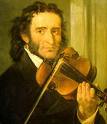Niccolo Paganini 1782 - 1840
September 21, 2008
 Niccolo
Paganini 1782 -
1840 was an Italian violinist, violist, guitarist, and composer.
Niccolo
Paganini 1782 -
1840 was an Italian violinist, violist, guitarist, and composer.
Paganini was a patient of Samuel Hahnemann and Simon Felix Camille Croserio for nervous exhaustion. Paganini, like many people of his day, suffered considerably under conventional medical treatment.
Paganini’s portrait was painted by Samuel Lover, and he was a friend of Louis Spohr.
The world’s greatest violinist, Niccolo Paganini, became Dr. Hahnemann’s patient in 1837. He had to postpone a concert due to “sickness in the trachea” (which may have been TB of the larynx).
For many years Paganini had received diverse diagnoses and treatment. Initially he was diagnosed as having syphillis and treated with mercury. Due to the mercury treatment, his all his teeth had fallen out, his mouth had ulcerated and he had abscesses on the jawbone.
Paganini also suffered from chronic erection for several years and could ejaculate by the mere sight of women. Due to connective tissue issues, he had hyperextension of his fingers and could play violin very rapidly. He was called the “demon” violinist.
One of the stories about Paganini is that he was a man of great frugality, always bargaining for a lower price. He had a habit of purchasing used clothing and then wearing it and patching it continually. He insisted that “an old garment is an old friend’. It is easy to understand from this, why Samuel Hahnemann prescribed homeopathic Sulphur, a remedy he usually started treatment with.
He told Paganini to “take 1 drop of solution already diluted, and mix with 30 spoons of water”. Hahnemann also advised against coffee and tea, and allowed only strongly diluted wine. Dr Hahnemann first gave Sulphur 30 and latter Pulsatilla 30… (Paganini greatly benefitted from his treatment with Samuel Hahnamann)…
Samuel Hahnemann realized that Paganini had gotten too familiar with his young wife, Melanie. Following the death of Paganini only three years later, a love letter to Melanie Hahnemann was found among his belongings.
Niccolo Paganini was born in Genoa, Italy, on October 27, 1782, the third of six children of Antonio and Teresa (neé Bocciardo) Paganini. Paganini’s father was an unsuccessful trader, but he managed to supplement his income through playing music on the mandolin.
At the age of five, Paganini started learning the mandolin from his father, and moved to the violin by the age of seven. His musical talents were quickly recognized, earning him numerous scholarships for violin lessons.
The young Paganini studied under various local violinists, including Giovanni Servetto and Giacomo Costa, but his progress quickly outpaced their abilities. Paganini and his father then traveled to Parma to seek further guidance from Alessandro Rolla. But upon listening to Paganini’s playing, Rolla immediately referred him to his own teacher, Ferdinando Paër and, later, Paër’s own teacher Gasparo Ghiretti. Though Paganini did not stay long with Paër or Ghiretti, the two had considerable influence on his composition style.
By age 18, Paganini was appointed first violin of the Republic of Lucca, but a substantial portion of his income came from freelancing. His fame as a violinist was only matched by his reputation as a gambler and womanizer.
In 1805, Lucca was annexed by Napoleonic France, and the region was ceded to Napoleon’s sister, Elisa Baciocchi. Paganini became a violinist for the Baciocchi court, while giving private lessons for her husband, Félix. In 1807, Baciocchi became the Grand Duchess of Tuscany and her court was transferred to Florence. Paganini was part of the entourage, but, towards the end of 1809, he left Baciocchi to resume his freelance career.
For the next few years, Paganini returned to touring in the areas surrounding Parma and Genoa. Though he was very popular with the local audience, he was still not very well known in Europe. His first break came from an 1813 concert which took place at La Scala in Milan. The concert was a great success, and as a result Paganini began to attract the attention of other prominent, albeit more conservative, musicians across Europe. His early encounters with Charles Philippe Lafont and Louis Spohr speculated intense rivalry, though all were successful enough later in their career, they only criticized each other’s playing style with patronism.
Paganini’s fame spread with successful concerts held in cities outside of Italy, in Vienna (1828), London, and Paris (both in 1831). His technical ability, and his willingness to display them, gained much acclaim from critics across Europe. In addition to his own compositions, theme and variations being the most popular, Paganini also performed modified versions of works (primarily concertos) written by his early contemporaries, such as Rodolphe Kreutzer and Giovanni Battista Viotti…
In Paris in 1833, he commissioned a viola concerto from Louis Hector Berlioz, who produced Harold in Italy for him, but Paganini never played it.
His health deteriorated due to mercury poisoning by the mercury compound used at that time to treat syphilis. The disease caused him to lose the ability to play violin, and he retired in ca.1834. He died of throat cancer in Nice on 27 May, 1840…